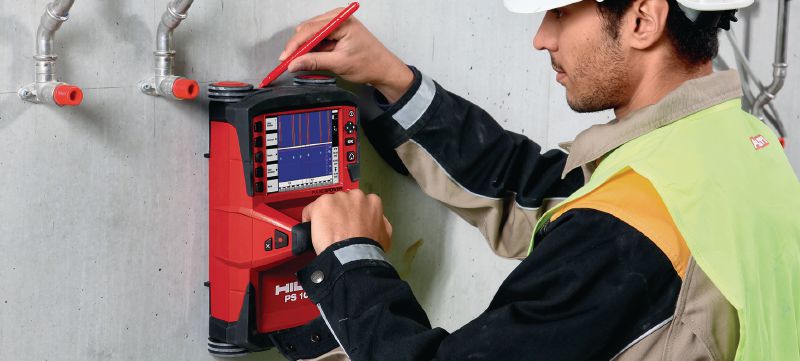RainierGPR Service Areas: Top Concrete Scanning Provider Across Regions
RainierGPR Service Areas: Top Concrete Scanning Provider Across Regions
Blog Article
Concrete Scanning: A Vital Step Towards Making Certain Architectural Honesty and Safety And Security
In the world of building and construction and framework upkeep, the relevance of concrete scanning can not be overemphasized. This meticulous procedure holds the vital to revealing possible risks hidden underneath the surface of seemingly solid frameworks. By using advanced innovation and techniques, concrete scanning works as a pivotal device in making certain that the honesty and safety and security of structures and bridges are maintained to the greatest criteria. However, past its surface-level implications, the function of concrete scanning expands far deeper than satisfies the eye.
Relevance of Concrete Scanning
Concrete scanning plays an essential function in ensuring the architectural integrity and safety of structures and framework jobs. By making use of sophisticated technologies such as ground-penetrating radar (GPR) and electro-magnetic induction, experts can non-destructively inspect concrete structures to detect prospective defects, voids, ingrained objects, and support layout. This process makes it possible for early discovery of anomalies that can compromise the security of a structure, avoiding pricey damages and making certain the safety and security of residents.
Prior to boring, reducing, or coring right into concrete, scanning assists identify the accurate places of rebar, post-tension cables, and various other ingrained aspects, decreasing the danger of unintentional hits that might lead to structural weaknesses. Additionally, concrete scanning aids in top quality control by validating the thickness of concrete covers and detecting any kind of discrepancies that might influence the overall sturdiness of the structure.
Technology for Concrete Evaluation

Benefits of Very Early Detection
Timely discovery of architectural problems can substantially reduce dangers and make sure the durability of building and construction tasks. By recognizing prospective problems at an early stage in the construction process, stakeholders can take positive procedures to resolve concerns prior to they escalate into bigger and a lot more expensive issues. One of the essential benefits of early detection is the avoidance of architectural failings, which can position serious safety risks and result in project hold-ups and financial losses.
Moreover, very early detection permits prompt repairs and maintenance, which can aid expand the lifespan of the structure. By dealing with problems quickly, building groups can avoid expensive repair services or perhaps the need for early substitute of architectural components. This positive strategy not only conserves time and cash yet likewise boosts the overall safety and security and longevity of the building and construction task.
Additionally, early discovery can improve project preparation and decision-making by providing stakeholders with important insights into the condition of the framework. Equipped with this details, project supervisors can make educated options pertaining to building and construction techniques, timelines, and materials, bring about more successful and reliable task end results.
Guaranteeing Architectural Stability
Ensuring the architectural security of a construction task is extremely important to its safety and security and long life. Structural security describes the capability of a structure or infrastructure to keep its kind and function under ecological conditions and various lots. To accomplish this, thorough assessment and monitoring of the structure are vital. Concrete scanning plays a crucial function in making sure architectural security by discovering more information prospective problems such as voids, delamination, or support corrosion that might endanger the stability of the framework in time.
By utilizing sophisticated scanning look what i found innovations like ground-penetrating radar (GPR) and electromagnetic induction, building experts can non-invasively examine concrete frameworks to determine locations of issue underneath the surface. This proactive technique allows for the early detection of defects or weak points, enabling timely repair services or reinforcement to avoid architectural failings.
Regular concrete scanning during various construction phases and throughout the life cycle of a structure can help maintain its stability, mitigate threats, and guarantee the safety and security of residents. By focusing on architectural stability with concrete scanning, construction tasks can improve their resilience and toughness, eventually contributing to greater security and durability.

Preventing Critical Failures
To secure against tragic occasions, precise tracking and proactive maintenance are imperative in averting critical failings within architectural frameworks. Detecting prospective concerns prior to they intensify is vital to avoiding architectural failures. Carrying out regular assessments, such as concrete scanning, can disclose concealed flaws like spaces, fractures, or rust that can endanger the honesty of a framework. By utilizing sophisticated scanning technologies like Ground Penetrating Radar (GPR) or Concrete X-ray, engineers can non-destructively examine the condition of concrete and recognize weak points that call for reinforcement or repair - RainierGPR Service Areas.

Verdict
Finally, concrete scanning plays a vital function in guaranteeing architectural honesty and safety by utilizing sophisticated technology for very early discovery of potential problems. This proactive technique helps avoid critical failures and guarantees the security of structures. It is necessary to prioritize concrete inspection as a basic practice to protect the long life and safety of structures and infrastructure.
Concrete scanning plays an important role in making sure the architectural stability and safety of buildings and framework tasks. Additionally, concrete scanning help in quality control by validating the thickness of concrete covers and finding any type of inconsistencies that may influence the total longevity of the structure. Concrete scanning plays an important duty in making certain structural stability by spotting prospective concerns such as voids, delamination, or reinforcement deterioration that might endanger the honesty of the structure over time.

In conclusion, concrete scanning plays an important function in visit here ensuring architectural stability and safety and security by making use of innovative modern technology for early discovery of possible issues.
Report this page